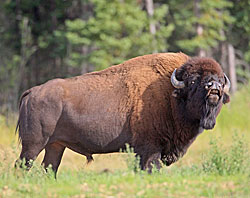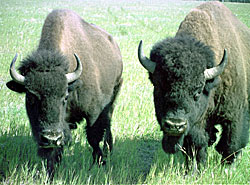Bison Identification

Unless you’ve been drawn for an any-sex bison hunt, your permit will be for either a bull or a cow bison. It is mandatory that you pre-identify and shoot only a bison of the sex indicated on your permit.
The physical differences that distinguish male (bull) from female (cow) bison are subtle. In fact, males and females can look very similar, especially when the males are not yet mature. In addition, for any particular characteristic, animals of the same sex can display significant variations. This makes the hunter’s job all the more difficult.

The table below lists characteristics to help you differentiate between bull and cow bison. The bottom line is: Do not rely on any single physical or behavioral characteristic to accurately identify the sex of a bison. Use multiple characteristics. Most hunters that mistakenly shoot the wrong sex bison concede later that they relied on only one characteristic and did not take the time to make a positive identification. Don’t make the same mistake.
The bottom line is, if there is any chance you could be making an error in selecting an animal, don’t shoot. You have a long period in which to hunt. Take your time and make a correct identification first.
Characteristics that can Help Identify Male and Female Bison
| Characteristic | Male | Female |
|---|---|---|
| Sex Organs | Penis sheath present but may be difficult to see on young bison or in late winter | Penis sheath absent but tufts of belly hair may look similar to a penis sheath |
| Horn Base Size | Generally larger than on cows; ranges from 2 ¾ inches in diameter on small bulls (very similar to large cows) to 3 ½ inches or more on large bulls | Generally smaller than on bulls; ranges from 2 – 2 ½ inches in diameter; horn bases on large cows often similar in size to those on small bulls |
| Adult Horn Shape | Adult horns point up, or curve inward on older bulls similar to cows; taper quickly from base | Adult horns generally curved, but may point up similar to bulls; taper slowly from base |
| Yearling Horn Shape | Point at 45 degree angle from head but longer and larger bases than yearling cows | Point at 45 degree angle from head but shorter and smaller bases than yearling bulls |
| Head Shape | Wider blockier forehead than cows; smaller bulls may appear similar to larger cows | Narrower forehead than bulls; large cows may appear similar to small bulls |
| Coat | Often two-tone; light & woolly on front shoulders, darker on back; may be single color | Often single color coat; can be two-tone |
| NOTE: Be sure to look at all features in order to make an accurate identification. The permit packet you receive by mail includes examples of recent bison identification mistakes. We strongly encourage you to study and learn from the mistakes other hunters have made. | ||
